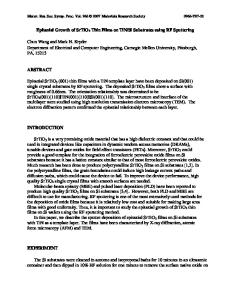Thickness Dependence of Transport Properties of Epitaxial SrRuO 3 Thin Films Grown on SrTiO 3 Substrates
- PDF / 419,232 Bytes
- 6 Pages / 612 x 792 pts (letter) Page_size
- 20 Downloads / 337 Views
Thickness dependence of transport properties of epitaxial SrRuO3 thin films grown on SrTiO3 substrates G. Herranz, F. Sánchez1, M.V. García-Cuenca1, C. Ferrater1, M. Varela1, B. Martínez and J. Fontcuberta Institut de Ciència de Materials de Barcelona – CSIC. Campus UAB, Bellaterra 08193. SPAIN 1 Dept. de Física Aplicada i Òptica, Universitat de Barcelona, Avda. Diagonal 647, Barcelona 08028. SPAIN ABSTRACT To study the effect of the film/substrate interface in thin films we have analyzed the thickness dependence of the transport properties of SrRuO3 films grown on SrTiO3 substrates. Our data makes evident the failure of the so-called dead layer model to describe the observed thickness dependence of the conductivity. This is interpreted as due to a non-monotonous change of microstructure as thickness increases. Indeed, Atomic Force Microscopy studies indicate substantial modifications of the growth mechanism with thickness. INTRODUCTION Since the discovery of colossal magnetoresistance in LaMnO3-based compounds1, oxide materials have become a subject of primary interest. In this framework SrRuO3 constitutes a specially attractive case both from the scientific and the technological points of view. From the technological point of view conductive metallic oxide thin films are of interest because they can be used as electrodes in microelectronic devices. In this sense, SrRuO3 is one of the most conductive metallic oxides with very good thermal conductivity, stability and resistance to corrosion. Furthermore, thin films of this material has been signaled as very promising candidates for magneto-optic and electro-optic applications 2. On the other hand, SrRuO3 is an interesting case of 4d itinerant ferromagnet 3,4 in which the appearance of the ferromagnetic (FM) ordering is accompanied by a reduction of the electrical resistivity. From the scientific point of view SrRuO3 offers an opportunity to study the relevance of the nature of the magnetic interactions, itinerant ferromagnetism in front of double exchange FM, in magnetoresistive devices and tunneling junctions. In bulk samples, the Curie temperature (TC) has been reported to be about 160 K 4,5 but values of TC≈140-144 K 6 are usually found in epitaxial thin films. This reduction of TC , as well as a reduction in the saturation magnetization, has been attributed to the existence of strain effects in thin films7. Saturation magnetization is about 1.6 µB/Ru in bulk single crystals and between 1.1-1.4 µB/Ru in epitaxial thin films6. At the same time, resistivity data also show important variations between bulk and thin film media and even between thin films of different thickness or prepared in different conditions 8. These discrepancies illustrate the fact that magnetic and transport properties may be strongly influenced by the interface with the substrate, and the actual microstructure of the films. Therefore, it is of primary importance to have a complete characterization of the film/substrate interface and the microstructure since they can play a crucial role in det
Data Loading...











